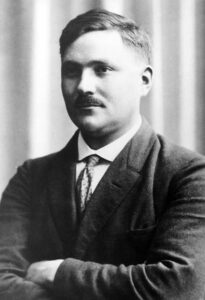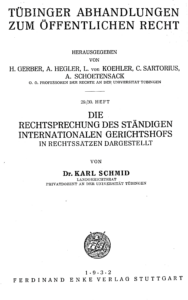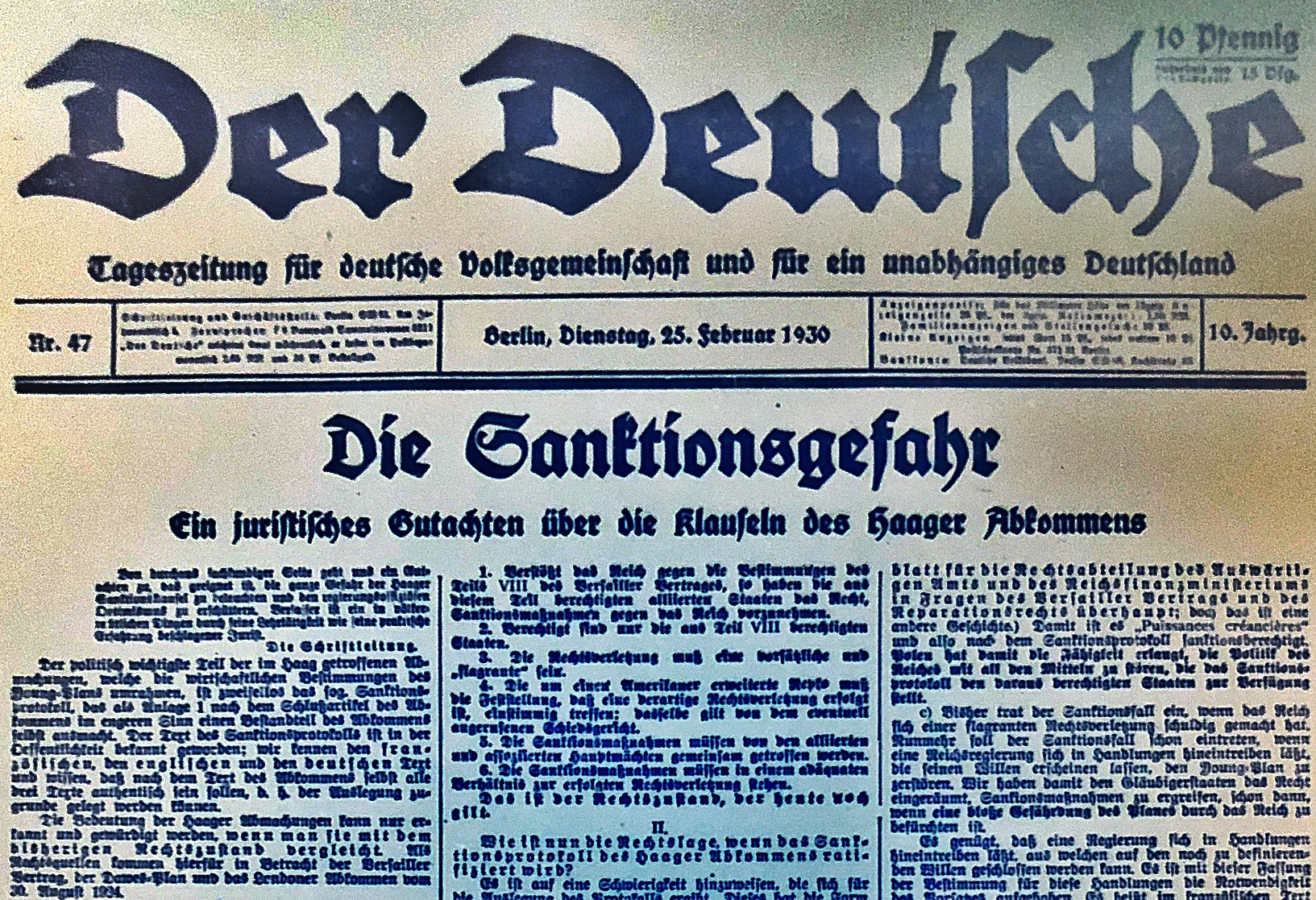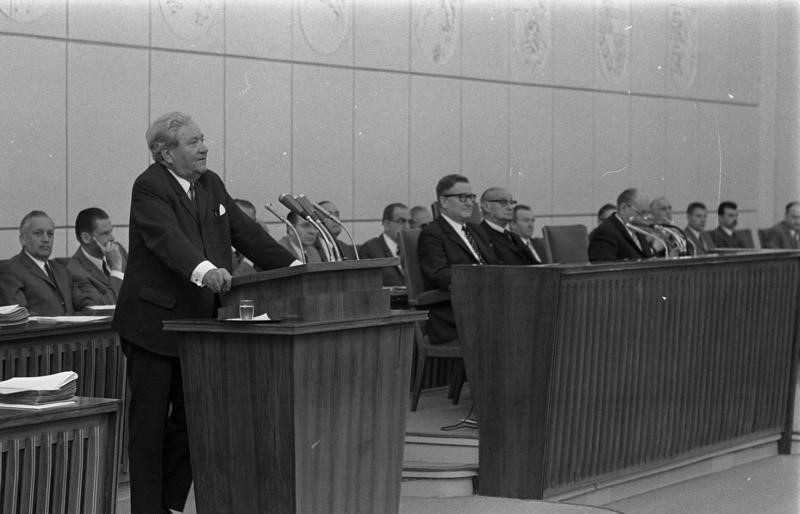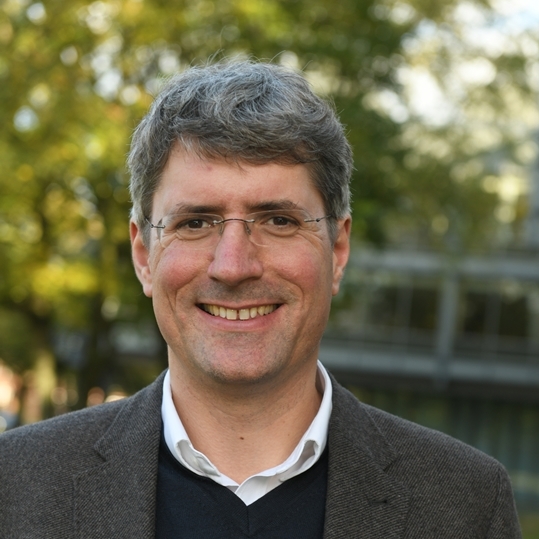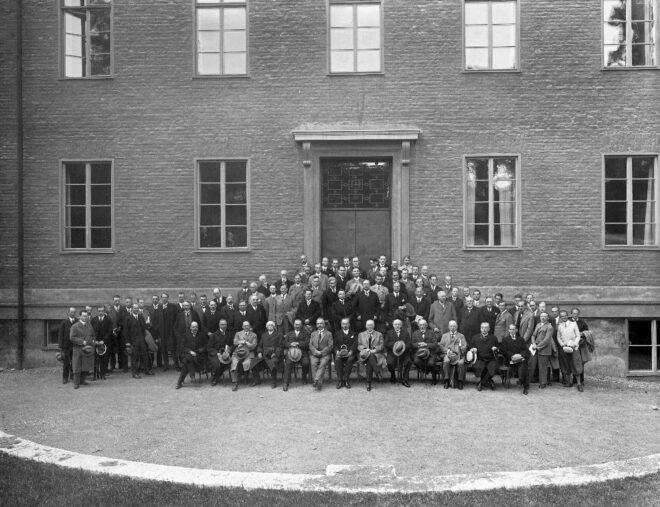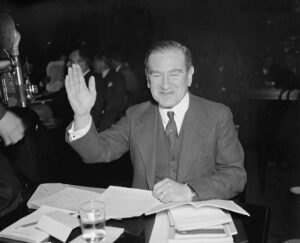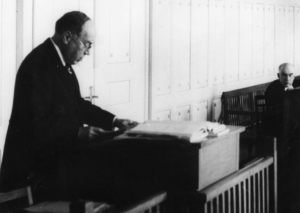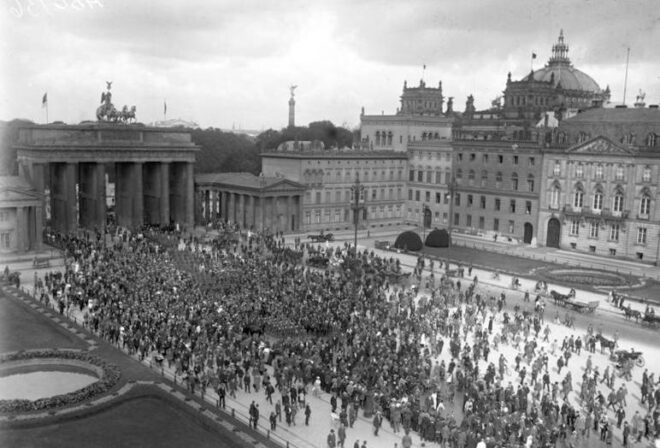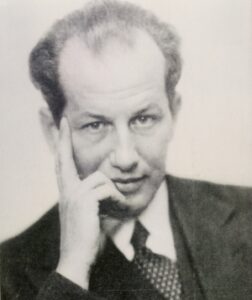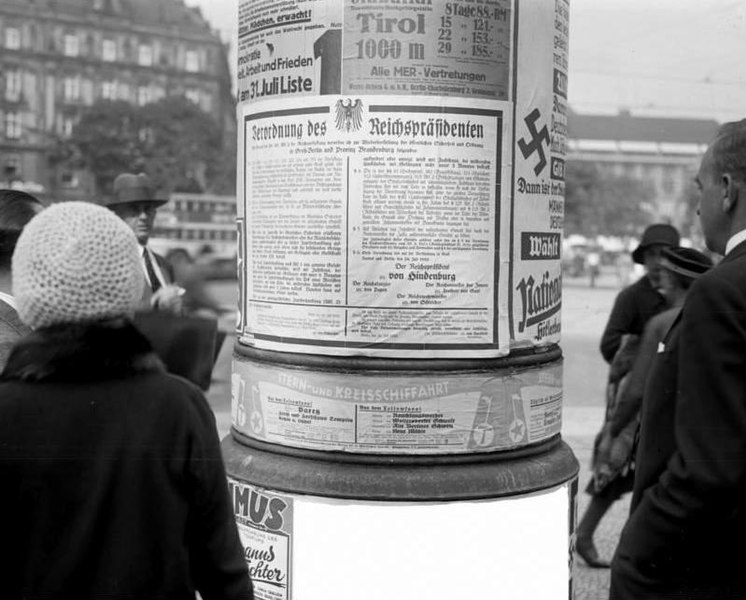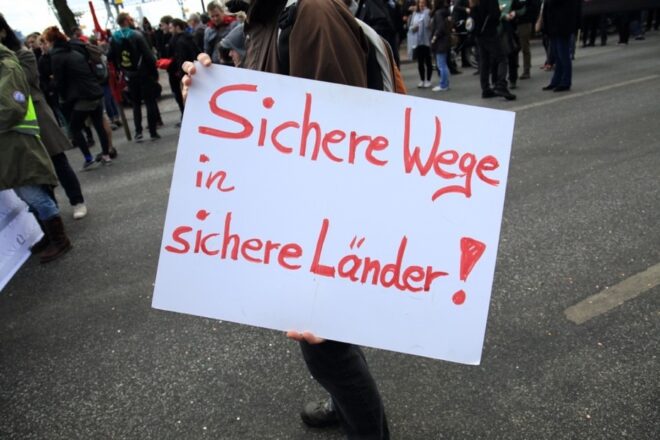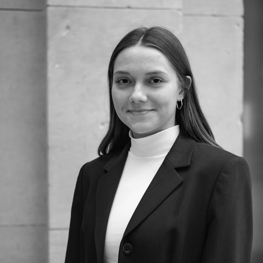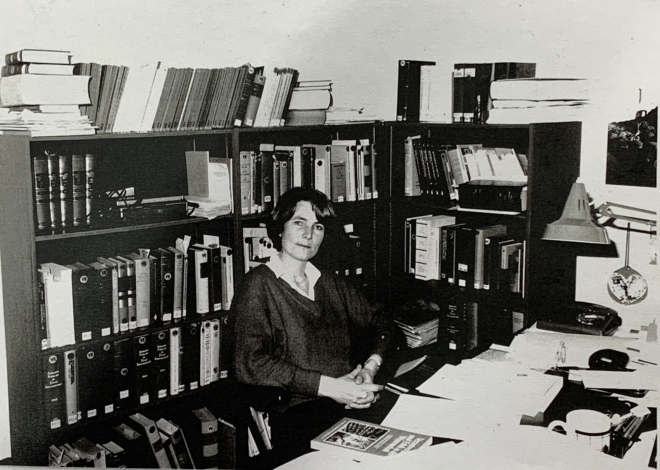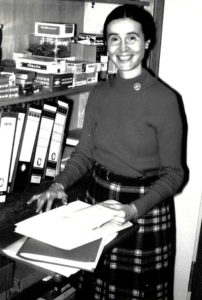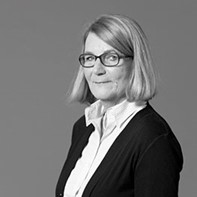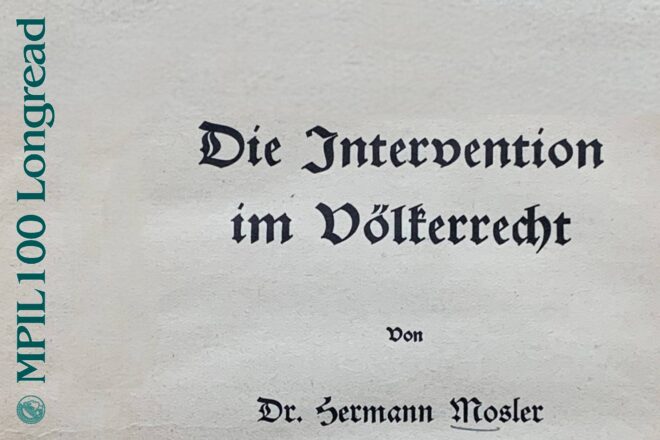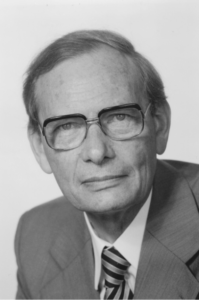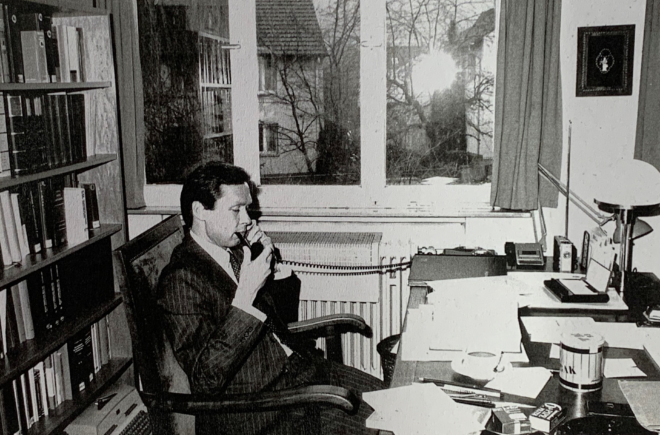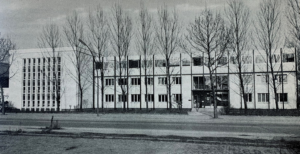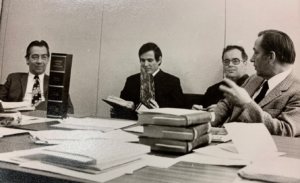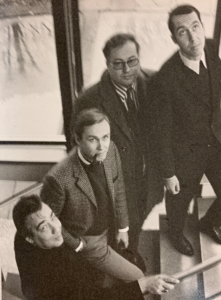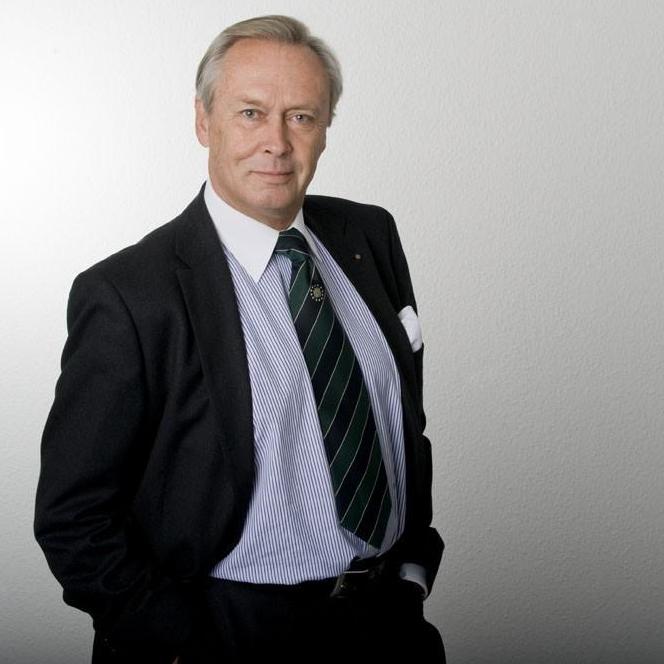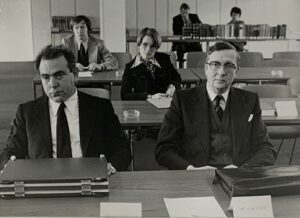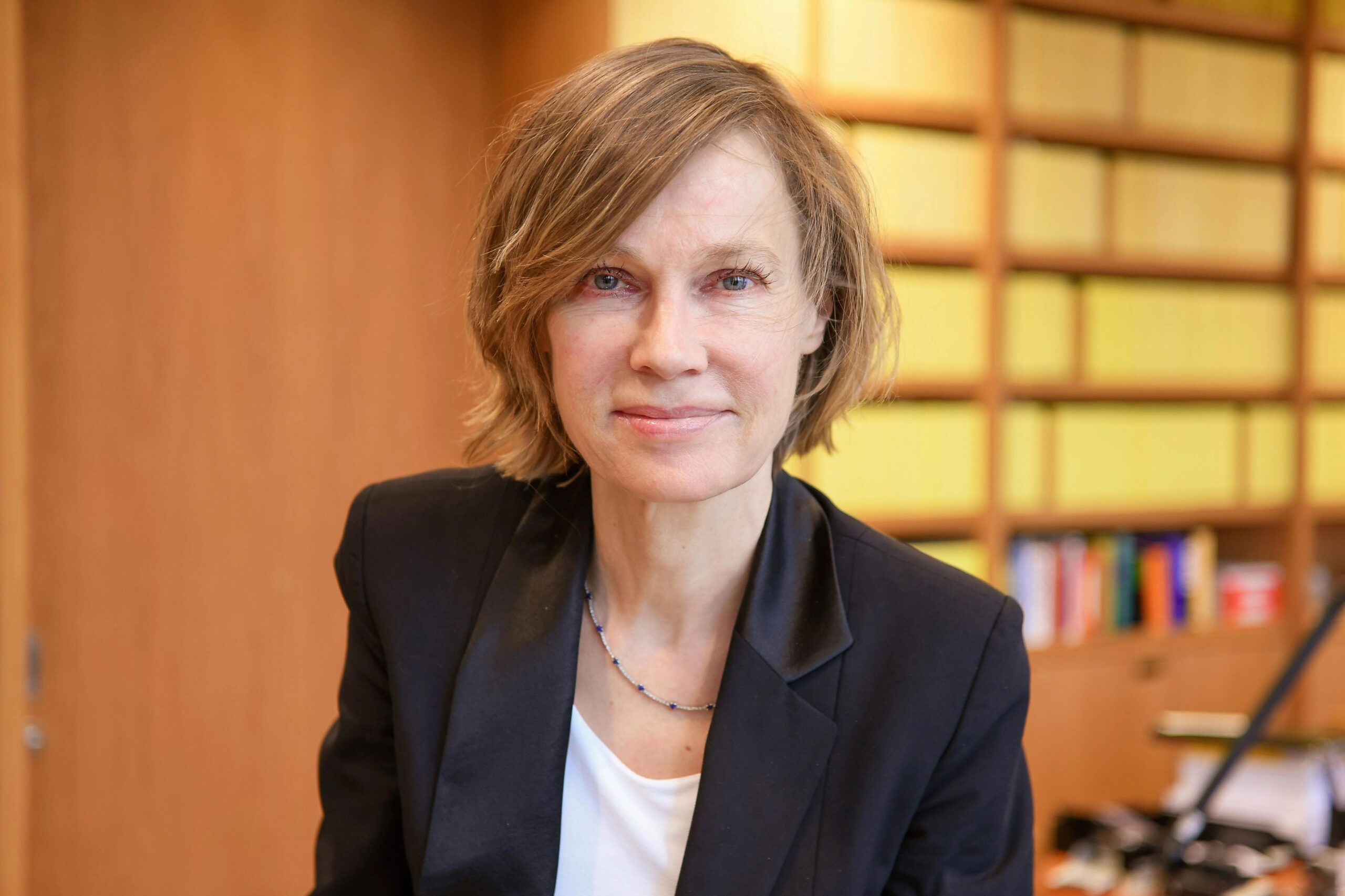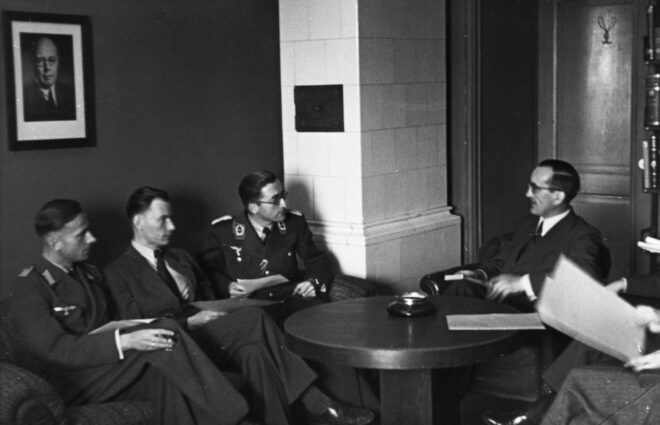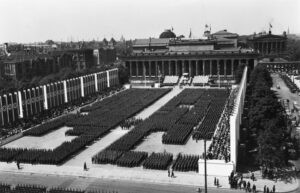“Un grand procès international”: The inaugural hearing of the deportees’ case before the German‑Belgian Mixed Arbitral Tribunal on 7 January 1924 at the Hôtel de Matignon in Paris. In the background, from left to right: Alfred Lenhard, Richard Hoene, Paul Moriaud, Albéric Rolin and the Belgian State Agents Henri Gevers and Georges Sartini van den Kerckhove. In the foreground: the German Secretary Walther Uppenkamp (left) and his Belgian colleague Jean Stevens (right) [Meurisse news agency, gallica.bnf.fr / Bibliothèque nationale de France]
Deutsch
Wie ein internationales Medienphänomen zum „Nicht-Erinnerungsort“ der Völkerrechtswissenschaft verkam – und seine Wiederentdeckung heute unser Verständnis von transnationalen Mobilisierungen verändern könnte
Am Morgen des 7. Januar 1924 begab sich ein Fotograf der Presseagentur Meurisse ins Pariser Hôtel de Matignon. Nicht etwa, um dort einer offiziellen Erklärung des Premierministers beizuwohnen – erst 1935 wurde das Stadtpalais zur offiziellen Residenz der französischen Regierungschefs. Der Pressefotograf sollte vielmehr ein damals neuartiges Spektakel ablichten, das die Brüsseler Tageszeitung Le Soir ihren Lesern als „grand procès international“ – als „großen internationalen Prozess“ – angekündigt hatte.[1]
Letzterer sollte vor dem auf Grund des Versailler Vertrages geschaffenen Deutsch‑Belgischen Gemischten Schiedsgericht stattfinden, dessen ständige Mitglieder der Genfer Rechtsgelehrte Paul Moriaud, sein namhafter belgischer Kollege Albéric Rolin und Senatspräsident Richard Hoene aus Frankfurt waren. Kläger waren zehn Belgier, die im Laufe des Krieges von Deutschland als Zwangsarbeiter deportiert worden waren und nun vom Reich eine Entschädigung verlangten. Einer der Kläger, der noch immer von seiner Gefangenschaft gezeichnete 38‑jährige Jules Loriaux, hatte den Weg nach Paris angetreten. Vertreten wurden er und seine Leidensgenossen durch den 33‑jährigen Brüsseler Anwalt Jacques Pirenne und dessen Mentor, den ehemaligen belgischen Außenminister Paul Hymans. Das Deutsche Reich hatte seinerseits nicht nur auf seinen Staatsvertreter, Senatspräsident Alfred Lenhard, sondern, wie üblich bei besonders wichtigen Fällen, zusätzlich auf einen Rechtsanwalt zurückgegriffen – in diesem Falle auf den später durch die NS-Rassenpolitik ins Exil getriebenen Max Illch aus Berlin, dessen akzentfreies Französisch von der Presse besonders hervorgehoben wurde.
Der Pariser Deportiertenprozess entsprach dem, was Karen J. Alter und Mikael Rask Madsen heute als „the international adjudication of mega-politics“ bezeichnen.[2] Hätte das Deutsche Reich damals diesen Prozess verloren, hätten ihm zehntausende solcher Klagen und Entschädigungsforderungen in Höhe von rund fünf Millionen Francs gedroht, das heißt das Zehnfache der Belgien für seine zivilen Kriegsopfer bereits versprochenen Summe.[3]
Das Deutsch-Belgische Gemischte Schiedsgericht war nur eines von siebzehn solcher Schiedsgerichte, die damals im Hôtel de Matignon einquartiert waren. Diese stellten damals ein Novum dar. Sieht man von dem schmalbrüstigen Zentralamerikanischen Gerichtshof ab, der zwischen 1907 und 1918 gerade einmal zehn Fälle behandelte, waren sie die ersten tatsächlich funktionierenden internationalen Gerichte vor denen Individuen gegen einen ausländischen – und teils sogar gegen den eigenen – Staat klagen konnten. Im Gegensatz zu ihrem zentralamerikanischen Vorgänger waren sie ein Massenphänomen: insgesamt gab es 39 Gemischte Schiedsgerichte, die grob geschätzt zwischen 90.000 und 100.000 Fälle behandelten – einige davon noch nach Kriegsausbruch 1939. Dieser Masse an, insbesondere für Deutschland, oft hochbrisanten Streitfällen verdankten auch das (Kaiser-Wilhelm-) Institut für ausländisches öffentliches Recht und Völkerrecht (1924) und jenes für ausländisches und internationales Privatrecht (1926) zumindest teilweise ihre Existenz und fortwährende staatliche Unterstützung.[4] Angesichts dieser Fakten scheint es umso verwunderlicher, dass die Gemischten Schiedsgerichte in der zweiten Hälfte des 20. Jahrhunderts fast gänzlich aus dem kollektiven Gedächtnis der Völkerrechtler verschwanden.
Die Gründe hierfür mögen vielfältiger Natur sein. Der Verruf, in den die für gescheitert erklärten internationalen Gebilde der Pariser Friedensordnung geraten waren, dürfte ebenso dazu gehören wie der üble Nachgeschmack, den insbesondere die Gemischten Schiedsgerichte bei den vor ihnen teils diskriminierten ehemaligen Mittelmächten, aber auch bei verschiedenen Alliierten – besonders in Mittel- und Südosteuropa – hinterlassen hatten. Auch dem Willen, den europäischen Wiederaufbau- und Einigungsprozess unter das Zeichen eines Neuanfangs zu stellen, wäre mit längeren Verweisen auf die in puncto Völkerversöhnung doch recht durchwachsene Bilanz der „Tribunaux arbitraux mixtes“ wohl kaum gedient gewesen. Auf Historiker dürfte nicht nur die Masse, sondern auch die technische Komplexität des lange noch reichlich vorhandenen Archivmaterials eine abschreckende Wirkung gehabt haben.
Fakt ist, dass, nach einer wahren Publikationsflut in der Zwischenkriegszeit, zwischen 1947[5] und den späten 2010er Jahren fast nichts zu diesem Thema erschienen ist. Im Gegensatz zu den, mit ihnen oft verglichenen, Gemischten Kommissionen, die sich insbesondere bei Anhängern der internationalen Investitionsschiedsgerichtsbarkeit stets großer Beliebtheit erfreut haben, entsprachen die Gemischten Schiedsgerichte damit durchaus dem vom französischen Sozio‑Historiker Gérard Noiriel geprägten Begriff eines „Nicht Erinnerungsorts“, eines „non‑lieu de mémoire“[6] – in anderen Worten, einem kollektiven Gedächtnisschwund der Völkerrechtsgemeinschaft. Wie real dieser Gedächtnisschwund war, verdeutlicht sich, wenn man bedenkt, dass das aus 40 größeren Kisten bestehende und mehrere Tonnen wiegende Archiv der Pariser und mehrerer anderer Gemischter Schiedsgerichte, dass den Weltkrieg nahezu intakt überstanden hatte, irgendwann Ende der 1970er oder Anfang der 1980er Jahre von der Bibliothek im Haager Friedenspalast ausgesondert wurde.[7]
Auch wenn große Teile der Hinterlassenschaft der Gemischten Schiedsgerichte damit für immer verloren sein dürften, so gibt es heute zumindest wieder Interesse an einer tiefgehenden Wiederaufarbeitung dieser Institutionen. Bahnbrechend sind hier vor allem Jakob Zollmanns Forschungen gewesen.[8] Darüber hinaus haben einige Publikationen anlässlich des 100. Jahrestages der Pariser Verträge, unter anderem von Marta Requejo Isidro und Burkhard Hess[9] sowie von August Reinisch,[10] es den Gemischten Schiedsgerichten zumindest ansatzweise erlaubt, den Rückweg in das Bewusstsein des völkerrechtlichen Mainstreams anzutreten. Diese Tendenz weiter zu verstärken und auszuweiten war auch das Vorhaben des Sammelbandes, den ich im April 2023 zusammen mit Hélène Ruiz Fabri herausgegeben habe und der das erste Buch zu diesem Thema seit 1947 darstellt.[11]
Die bereits in dieser Publikation vertretenen Ansätze können durchaus noch ausgebaut werden. Fünf Themenkomplexe erscheinen mir in dieser Hinsicht besonders vielversprechend – unter anderem deshalb, weil sie auch neueren methodologischen Ausrichtungen ein weites Betätigungsfeld bieten können, vor allem im Bereich der Sozio-Rechtsgeschichte. Hier denke ich insbesondere an die von Natasha Wheatley[12] und Jessica Marglin[13] veröffentlichten Arbeiten über die Mobilisierung des Völkerrechts und internationaler Institutionen sowohl durch Eliten als durch Graswurzelbewegungen. Aber auch klassischere rechtsgeschichtliche und biographische Herangehensweisen unter Herbeiziehung von Archivmaterial wären hier möglich.
1. Die Bedeutung der Gemischten Schiedsgerichte für das Auswärtige Amt und das KWI
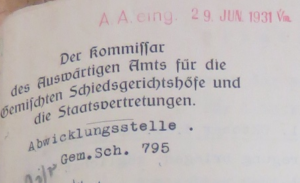
Aus der Rechtsabteilung des Auswärtigen Amts ausgeschieden: Briefkopf des auch als „Schiedsgerichtsabteilung“ bekannten Kommissariats Otto Göpperts (1931) [14]
Dieser Themenkomplex ist natürlich von besonderer Relevanz für die Aufarbeitung der Geschichte des Kaiser Wilhelm Instituts (KWI) für ausländisches öffentliches Recht und Völkerrecht, welches seine Existenz zu einem guten Teil dem Bedürfnis der Weimarer Republik nach einer sowohl personell als argumentativ angemessenen Vertretung vor den Gemischten Schiedsgerichten verdankt. Einige KWI-Mitglieder wirkten sogar direkt an Gemischten Schiedsgerichten mit. So war der KWI-Direktor Viktor Bruns Schiedsrichter von 1927 bis 1931 am Deutsch‑Polnischen und auch am Deutsch‑Tschechoslowakischen Gemischten Schiedsgericht. Sein Kollege Erich Kaufmann war um die gleiche Zeit deutscher Staatsvertreter unter anderem vor dem Deutsch‑Polnischen Gemischten Schiedsgericht. Beiden Professoren assistierte hierbei Carlo Schmid, der von 1927 bis 1929 Referent am KWI war.[15] Das Ergebnis dieser beratenden Tätigkeit war zum Teil widersprüchlich. Wie bereits durch Jakob Zollmann aufgezeigt, trug das KWI zwar durch seine Publikationen und Gutachten wesentlich dazu bei, die Qualität der durch die deutschen Staatsvertreter vorgebrachten völkerrechtlichen Argumente zu verbessern, verfestigte aber auch innerhalb Deutschlands das Verständnis der Versailler Friedensordnung als eines grundlegend ungerechten „Diktats“. Um diese Dynamik eingehender zu beleuchten, wäre es sicher auch angebracht, eine Studie über das 1923 innerhalb des Auswärtigen Amtes geschaffene „Kommissariat für die Gemischten Schiedsgerichtshöfe und die Staatsvertretungen“ anzustrengen, das unter der Leitung von Dr. Otto Göppert stand und zeitweise über 300 Mitarbeiter beschäftigte, darunter über 70 Juristen.[16] Die Arbeit dieses Kommissariats und seiner Mitarbeiter näher zu erforschen dürfte nicht nur für das Verständnis der deutschen Völkerrechtsdiplomatie in der Zwischenkriegszeit interessant sein, sondern es auch erlauben, Kontinuitäten und Diskontinuitäten mit der Nachkriegszeit aufzuzeigen, insbesondere im Hinblick auf den europäischen Einigungsprozess.
2. Die Gemischten Schiedsgerichte und das internationale Privatrecht

Ernst Rabel (1874‑1955) war nicht nur von 1926 bis 1937 Leiter des KWI für ausländisches und internationales Privatrecht, sondern auch von 1921 bis 1930 Mitglied des Deutsch‑Italienischen Gemischten Schiedsgerichts mit Sitz in Rom.[17]
Da die Zuständigkeit der Gemischten Schiedsgerichte sich auch auf Fragen des internationalen Privatrechts erstreckte, hegten manche zeitgenössischen Juristen wie zum Beispiel. Jean‑Paulin Niboyet den Wunsch, dass die von ihnen entwickelte Rechtsprechung zu einer Harmonisierung der in den verschiedenen europäischen Staaten geltenden Regeln führen würde.[18] Obwohl diese Vorstellung sich nicht verwirklichen sollte, könnten die damaligen Diskussionen trotzdem für heutige Spezialisten des internationalen Privatrechts interessant sein. Darüber hinaus wurde das KWI für ausländisches und internationales Privatrecht 1926 ebenfalls mit Hinblick auf die sich vor den Gemischten Schiedsgerichten stellenden Rechtsfragen gegründet und hatte mit Ernst Rabel – ähnlich wie sein völkerrechtliches Pendant mit Viktor Bruns – einen Direktor, der als Schiedsrichter an einem solchen Gericht fungierte. Die Erforschung dieser Zusammenarbeit dürfte sicher weitere interessante Erkenntnisse über das Verhältnis zwischen Rechtswissenschaft und Politik im Deutschland der Zwischenkriegszeit liefern.
3. Die Gemischten Schiedsgerichte und die Entstehung einer transnationalen juristischen Öffentlichkeit

Ein internationales Medienereignis: Kläger und Publikum zum Auftakt des Pariser Deportiertenprozesses am 7. Januar 1924. Im Vordergrund die Anwälte Jacques Pirenne (links) und Paul Hymans (rechts). Im Hintergrund der Hauptkläger Jules Loriaux (zweiter v. r., mit Gehstock) [19]
Angesichts der Anzahl der vor ihnen verhandelten Fälle und der teils beträchtlichen damit verbundenen finanziellen und politischen Konsequenzen, schufen die Gemischten Schiedsgerichte ein neues transnationales Betätigungsfeld, das sowohl von Angehörigen von Rechtsberufen wie von Teilen der Zivilgesellschaft wahrgenommen wurde. Da die Verhandlungen vor den Gemischten Schiedsgerichten öffentlich waren, auch von der Presse kommentiert wurden und sogar Schaulustige anzogen, kann man hier durchaus von einer transnationalen juristischen Öffentlichkeit sprechen. Dieser Faktor erlaubte es unter anderem, dass eher unprivilegierte Akteure, wie zum Beispiel Kriegsgeschädigte, die Gemischten Schiedsgerichte dafür benutzten, ihre Interessen gegen ehemalige Feindstaaten – oder gar gegen ihren eigenen Staat – durchzusetzen oder zumindest zur Sprache zu bringen. Einige dieser Verfahren, wie etwa der anfangs erwähnte Deportiertenprozess vor dem Deutsch‑Belgischen Gemischten Schiedsgericht, wurden auch medial transnational rezipiert.
Aber auch Teilen der Eliten boten die Gemischten Schiedsgerichte neue Möglichkeiten. Insbesondere Paris entwickelte sich zum Mittelpunkt einer transnationalen Juristen‑Gemeinschaft. International bestens vernetzte Anwälte entwickelten sich hier zu Spezialisten in deutsch‑französischen und anderen transnationalen Streitfällen. Gemeinsam mit Mitgliedern der Gemischten Schiedsgerichte und der Internationalen Handelskammer versuchten sie sogar, das System dieser Gerichte zu reformieren und dauerhaft zu etablieren. Die Motivationen, Argumente und Aktionen all dieser Akteure zu erforschen, würde sicherlich einen Beitrag zur Entwicklung der Sozio‑Rechtsgeschichte leisten.
4. Die Gemischten Schiedsgerichte und die Neuordnung der Besitzverhältnisse in Mittel‑ und Südosteuropa

Sitzung des Deutsch‑Polnischen Gemischten Schiedsgerichts im Pariser Hôtel de Matignon im Februar 1925. Im Hintergrund v. l. n. r.: Alfred Lenhard, Franz Scholz, Robert Guex, Jan Namitkiewicz, Tadeusz Sobolewski. Im Vordergrund die beiden Sekretäre, deren Identität nicht genauer bestimmt werden konnte [20]
Anders als die westlichen Alliierten genossen Polen und die Mitglieder der „Kleinen Entente“ vor den mit ihnen eingerichteten Gemischten Schiedsgerichten keine weitgehende Immunität gegenüber Klagen von Angehörigen ehemaliger Mittelmächte. Ganz im Gegenteil: die Pariser Friedensverträge sahen sogar ausdrücklich deren Entschädigung für etwaige Eigentumsliquidationen vor, was die Neuordnung der Besitzverhältnisse in diesen, teils gerade unabhängig gewordenen, Staaten zu behindern drohte. Besonders die Streitfälle zwischen deutschen Klägern und der Polnischen Republik sowie der rumänisch‑ungarische Optantenstreit sorgten hierbei für internationale Schlagzeilen. Hier wäre es interessant, den Einfluss dieser Prozeduren auf das Souveränitätsverständnis der beteiligten Staaten sowie die Mobilisierung der beteiligten Akteure, sowohl in der Region als auch in Westeuropa, zu untersuchen.
5. Die Gemischten Schiedsgerichte jenseits von Europa
Dieser Themenkomplex entspringt der Erkenntnis, dass die Gemischten Schiedsgerichte trotz ihres Ursprungs in den Pariser Friedensverträgen nicht als ein rein europäisches Phänomen verstanden werden dürfen, sondern in dreierlei Hinsicht darüber hinausgingen. Erstens fällt beim Betrachten der Liste der 39 Gemischten Schiedsgerichte[21] auf, dass nicht nur europäische, sondern auch zwei außereuropäische Alliierte an diesen Gerichten beteiligt waren, nämlich Japan und Siam. Noch harren die Archive dieser Staaten zu ihrer Beteiligung an den Gemischten Schiedsgerichten – die zumindest im Falle Japans noch immer bestehen – einer wissenschaftlichen Aufarbeitung. Diese wäre umso interessanter, als sie die Wahrnehmung der Versailler Friedensordnung und der internationalen Schiedsgerichtsbarkeit durch diese Staaten weiter beleuchten könnte. Zweitens gilt es, auf den besonderen Wert der nach dem Lausanner Friedensvertrag von 1923 mit der Türkei in Istanbul aufgestellten Gemischten Schiedsgerichte hinzuweisen: zum einen, weil sie die an ihnen beteiligten Staaten und deren Staatsangehörige gleich behandelten und damit als zukunftsfähiges Modell dargestellt werden konnten; zum anderen, weil sie trotz dieses Unterschiedes von der Türkei als eine Neuauflage der für semi‑koloniale Rechtsordnungen typischen „gemischten Gerichtshöfe“ wahrgenommen wurden und damit auch die Frage der Kontinuitäten und Diskontinuitäten zwischen Kolonialismus und Internationalismus stellen. Drittens dürfte es insbesondere aus sozio‑rechtsgeschichtlicher Perspektive interessant sein, Fälle mit außereuropäischen Klägern (zum Beispiel alliierten Kolonialuntertanen) oder einem außereuropäischen Bezug zu analysieren.
[1] „Un grand procès international: Les déportés belges contre le Reich“, in: Le Soir, 9. Januar 1924.
[2] Karen J. Alter/Mikael Rask Madsen, The International Adjudication of Mega-Politics, Law and Contemporary Problems 84 (2021), 1.
[3] Siehe hierzu: Michel Erpelding, An Example of International Legal Mobilisation: The German–Belgian Mixed Arbitral Tribunal and the Case of the Belgian Deportees, in: Hélène Ruiz Fabri/Michel Erpelding (Hrsg.), The Mixed Arbitral Tribunals, 1919–1939: An Experiment in the International Adjudication of Private Rights, Baden-Baden: Nomos 2023, 309-362.
[4] Jakob Zollmann, Mixed Arbitral Tribunals: Post-First World War Peace Treaties, in: Hélène Ruiz Fabri (Hrsg.), Max Planck Encyclopedia of International Procedural Law, Oxford: Oxford University Press 2022, § 32.
[5] Charles Carabiber, Les juridictions internationales de droit privé, Neuchâtel: La Baconnière 1947 (mit einem Vorwort von Georges Scelle).
[6] Gérard Noiriel, Le creuset français: histoire de l’immigration, XIXe-XXe siècle, Paris: Seuil 1988, 19.
[7] Email-Austausch zwischen dem Autor und der Bibliothek im Friedenspalais, August-September 2020.
[8] Siehe u. a.: Jakob Zollmann, Reparations, Claims for Damages, and the Delivery of Justice: Germany and the Mixed Arbitral Tribunals (1919-1933), in: David Deroussin (Hrsg.), La Grande Guerre et son droit, Paris: LGDJ 2018, 379-394; Jakob Zollmann, Un juge berlinois à Paris entre droit public international et arbitrage commercial. Robert Marx, les tribunaux arbitraux mixtes et la Chambre de commerce internationale, in: Philipp Müller/Hervé Joly (Hrsg.), Les espaces d’interaction des élites françaises et allemandes. 1920-1950, Rennes: Presses Universitaires de Rennes 2021, 63-77.
[9] Marta Requejo Isidro/Burkhard Hess, International Adjudication of Private Rights: The Mixed Arbitral Tribunals in the Peace Treaties of 1919-1922, in: Michel Erpelding/Burkhard Hess/Hélène Ruiz Fabri (Hrsg.), Peace Through Law: The Versailles Peace Treaty and Dispute Settlement After World War I, Baden-Baden: Nomos 2019, 239-276.
[10] August Reinisch, The Establishment of Mixed Arbitral Tribunals, in: Société française pour le droit international (Hrsg.), Le Traité de Versailles: Regards franco-allemands en droit international à l’occasion du centenaire / The Versailles Treaty: French and German Perspectives in International Law on the Occasion of the Centenary, Paris: Pedone 2020, 267-288.
[11] Hélène Ruiz Fabri/Michel Erpelding (Hrsg.), The Mixed Arbitral Tribunals, 1919–1939: An Experiment in the International Adjudication of Private Rights, Baden-Baden: Nomos 2023.
[12] Natasha Wheatley, Mandatory Interpretation: Legal Hermeneutics and the New International Order in Arab and Jewish Petitions to the League of Nations, Past and Present 227 (2015), 205-248.
[13] Jessica M. Marglin, Notes towards a socio-legal history of international law, Legal History 29 (2021), 277-278; Jessica M. Marglin, The Shamama Case: Contesting Citizenship across the Modern Mediterranean, Princeton: Princeton University Press 2022.
[14] PA AA, RZ 403 53267.
[15] Carlo Schmid, Erinnerungen, Bern: Scherz 1979, 123-128.
[16] Otto Göppert, Zur Geschichte der auf Grund des Vetrags von Versailles eingesetzten Gemischten Schiedsgerichte und Schiedsinstanzen für Neutralitätsansprüche, unveröffentlichtes Typoskript, Berlin, März 1931, 34.
[17] Eckart Henning/Marion Kazemi: Handbuch zur Institutsgeschichte der Kaiser-Wilhelm- /Max-Planck-Gesellschaft 1911-2011, Teil II/1, Berlin: Archiv zur Geschichte der Max-Planck-Gesellschaft 2016, 881.
[18] Jean-Paulin Niboyet, Les Tribunaux arbitraux mixtes organisés en exécution des traités de paix, Bulletin de l’Institut intermédiaire international 7 (1922), 215-241.
[19] Presseagentur Meurisse, gallica.bnf.fr / Bibliothèque nationale de France.
[20] Narodowe Archiwum Cyfrowe.
[21] Appendix: Alphabetical List of the Mixed Arbitral Tribunals and their Members, in: Ruiz Fabri/Michel Erpelding (Hrsg.), The Mixed Arbitral Tribunals, 1919–1939: An Experiment in the International Adjudication of Private Rights, Baden-Baden: Nomos 2023, 547-581.
|
Suggested Citation: Michel Erpelding, Die Gemischten Schiedsgerichte der Zwischenkriegszeit, MPIL100.de, DOI: 10.17176/20240327-093718-0 |
|
| Lizenz: CC BY-NC-SA 4.0 DEED | |
English
How a former international media phenomenon became one of international laws ”spaces of collective amnesia“ – and how its recent rediscovery could change our understanding of transnational mobilisation
On the morning of 7 January 1924, a photographer from the Meurisse news agency went to the Hôtel de Matignon in Paris. Not to attend an official declaration by the Prime Minister – the townhouse only became the official residence of the French head of government in 1935. Rather, the press photographer was to photograph a spectacle that was novel at the time andwhich the Brussels daily newspaper Le Soir had announced to its readers as ”un grand procès international“ – a ”great international trial“.[1]
The proceedings were to take place before the German‑Belgian Mixed Arbitral Tribunal established pursuant to the Treaty of Versailles and whose permanent members were the Geneva legal scholar Paul Moriaud, his renowned Belgian colleague Albéric Rolin, and Richard Hoene, a senior judge (”Senatspräsident“) from Germany. The plaintiffs were ten Belgians who had been deported by Germany as forced labourers during the war and were now demanding compensation from the Reich. One of the claimants, 38‑year‑old Jules Loriaux, who was still scarred by his imprisonment, had travelled to Paris. He and his fellow deportees were represented by the 33‑year‑old Brussels lawyer Jacques Pirenne and his mentor, the former Belgian Foreign Minister Paul Hymans. For its part, the German Reich not only had recourse to its state representative, Senatspräsident Alfred Lenhard, but, as usual in particularly important cases, also to a lawyer – in this case Max Illch from Berlin, who would later be driven into exile by Nazi racial policy and whose accent-free French earned him some recognition from the press.
The Belgian deportees’ case was what Karen J. Alter and Mikael Rask Madsen today refer to as ”the international adjudication of mega-politics”.[2] If Germany had lost this case at the time, it would have faced tens of thousands of such lawsuits and claims for compensation adding up to around five million francs, i.e. ten times the sum it had already agreed to pay to Belgium for its civilian war victims.[3]
The German‑Belgian Mixed Arbitral Tribunal was just one of seventeen Mixed Arbitral Tribunals (MATs) that were housed in the Hôtel de Matignon. They were an altogether new kind of international court. With the exception of the short-lived and little-used Central American Court of Justice, which dealt with just ten cases between 1907 and 1918, they were the first actually functioning international tribunals before which individuals could sue a foreign – and sometimes even their own – state. In contrast to their Central American predecessor, the MATs were a mass phenomenon: all in all, there were 39 of them, which would deal with roughly between 90,000 and 100,000 cases – some of them even after the outbreak of war in 1939. The (Kaiser Wilhelm) Institute for Comparative Public Law and International Law (1924), just as the one for Comparative and International Private Law (1926), owed at least part of its existence and continued state support to this mass of often highly sensitive disputes, particularly for Germany.[4] In view of these facts, it seems all the more surprising that the MATs disappeared almost completely from the collective memory of international law scholars in the second half of the 20th century.
The reasons for this are likely manifold. The discredit to which the international structures of the Paris peace order, which had been declared a failure, had fallen, was probably one of them, as was the bad aftertaste that the MATs in particular had left behind not only among the former Central Powers, some of whom had been discriminated against before them, but also among various Allies – particularly in Central and South-Eastern Europe. The desire to place the European reconstruction and unification process after the Second World War under the sign of a new beginning and to focus on international reconciliation would also hardly have been served by lengthy references to the rather mixed record of the MATs. Moreover, historians are likely to have been deterred not only by the sheer volume but also by the technical complexity of the (then) still abundant archive material.
The fact is that after a veritable flood of publications in the interwar period almost nothing was published on this topic between 1947[5] and the late 2010s. In this regard, their fate contrasts with that of the Mixed Commissions created during the 19th century and the first half of the 20th century, with which the MATs have often been compared. Whereas the Mixed Commissions have always enjoyed great popularity, especially among supporters of international investment arbitration, the MATs turned into an example of what the French socio-historian Gérard Noiriel described as a ”non-lieu de mémoire”,[6] a ”space of collective amnesia” – in this case, of the international legal community. Just how real this loss of memory was, becomes clear when one considers that the archives of the Paris and several other MATs, consisting of 40 large boxes and weighing several tonnes, which had survived the Second World War almost intact, were discarded by the Peace Palace Library sometime in the late 1970s or early 1980s.[7]
Even if large parts of the legacy of the MATs are thus probably lost forever, there is at least renewed interest today in an in‑depth reappraisal of these institutions. Jakob Zollmann’s research has been particularly ground‑breaking in this regard.[8] In addition, several publications on the occasion of the 100th anniversary of the Paris Treaties, notably those by Marta Requejo Isidro and Burkhard Hess[9] as well as August Reinisch,[10] have at least to some extent allowed the MATs to make their way back into the consciousness of the international law mainstream. Further strengthening and expanding this trend was also the aim of the anthology that I edited together with Hélène Ruiz Fabri in April 2023 and which is the first book on this topic since 1947.[11]
The approaches already represented in this publication can certainly be expanded on. Five general themes seem particularly promising to me in this respect – partly because they can also offer a broad field of activity for newer methodological orientations, especially in the area of socio‑legal history. Here I am thinking in particular of the work published by Natasha Wheatley[12] and Jessica Marglin[13] on the mobilisation of international law and international institutions by both elites and grassroots movements. But more classical legal‑historical and biographical approaches, drawing on archival material, would also be possible here.
1. The Significance of the Mixed Arbitral Tribunals for the German Foreign Office and the Kaiser Wilhelm Institute

Distinct from the German Foreign Office’s Legal Department: Letterhead of Otto Göppert’s ”Commissariat“, also known as the ”Department of Arbitral Tribunals“ (1931) [14]
This general theme is, of course, of particular relevance for the history of the Kaiser Wilhelm Institute (KWI) for Comparative Public Law and International Law, which owes its existence in large part to the need of the Weimar Republic for adequate representation before the MATs, both in terms of personnel and arguments. Some KWI members even participated directly. KWI Director Viktor Bruns, for example, was an arbitrator on the German‑Polish and German‑Czechoslovakian Mixed Arbitral Tribunals from 1927 to 1931. Around the same time, his colleague Erich Kaufmann was a German state agent before the German‑Polish Arbitral Tribunal, among others. Both professors were assisted by Carlo Schmid , who was a research fellow at the KWI from 1927 to 1929.[15] The result of this advisory activity was in part contradictory. As Jakob Zollmann has already pointed out, although the KWI’s publications and expert opinions contributed significantly to improving the quality of the arguments on international law put forward by German state representatives, they also reinforced the understanding of the Versailles peace order within Germany as a fundamentally unjust ”dictate”. In order to shed more light on this dynamic, it would certainly also be appropriate to undertake a study of the ”Commissariat for the Mixed Arbitral Tribunals and the State Agencies” (”Kommissariat für die Gemischten Schiedsgerichtshöfe und die Staatsvertretungen“), which was created within the Foreign Office in 1923, headed by Dr Otto Göppert, and at times employed over 300 staff members, including over 70 lawyers.[16] Researching the work of this commissariat and its staff in more detail should not only be interesting for understanding German diplomacy in international law in the interwar period, but also allow for continuities and discontinuities with the post-war period to be identified, particularly with regard to the European unification process.
2. The Mixed Arbitral Tribunals and Private International Law

Ernst Rabel (1874–1955) did not only hold the position of Director of the KWI for Comparative and International Private Law between 1926 and 1936, but also sat on the German‑Italian Arbitral Tribunal based in Rome between 1921 and 1930.[17]
As the jurisdiction of the MATs also extended to questions of private international law, some contemporary jurists, such as Jean‑Paulin Niboyet, hoped that the case law they developed would lead to a harmonisation of the rules applicable in the various European states.[18] Although this idea was not to be realised, the discussions at the time could still be of interest to today’s specialists in private international law. Furthermore, the KWI for Foreign and International Private Law was also founded in 1926 with a view to the legal issues arising before the MATs and with Ernst Rabel – similar to his international law counterpart, with Viktor Bruns – had a director who sat as a MAT member. Research into this co‑operation should certainly provide further interesting insights into the relationship between jurisprudence and politics in interwar Germany.
3. The Mixed Arbitral Tribunals and the Emergence of a Transnational Legal Public Sphere

An international media event: Plaintiffs and public at the inaugural hearing of the deportees’ case in Paris on 7 January 1924. In the foreground: lawyers Jacques Pirenne (left) and Paul Hymans (right). In the background: main plaintiff Jules Loriaux (2nd from the right, with cane)[19]
Given the number of cases heard before them and the sometimes considerable financial and political consequences associated with them, the MATs created a new transnational field of activity that was recognised by both members of the legal profession and parts of civil society. Since the hearings before the MATs were public and were also commented on by the press and even attracted onlookers, one can certainly speak of a transnational legal public sphere. This factor made it possible, among other things, for rather unprivileged actors, such as war victims, to use the MATs to assert their interests against former enemy states – or even against their own state – or at least to raise them. Some of these proceedings, such as the deportees’ case before the German‑Belgian MAT mentioned above, also received transnational media coverage.
However, the MATs also offered new opportunities to parts of the elite. Paris in particular developed into the centre of a transnational legal community. Lawyers with excellent international networks developed into specialists in Franco German and other transnational disputes. Together with members of the MATs and the International Chamber of Commerce, they even attempted to reform the system of these courts and establish it on a permanent basis. Researching the motivations, arguments and actions of all these actors would certainly contribute to the development of socio‑legal history.
4. The Mixed Arbitral Tribunals and the Reorganisation of Property Relations in Central and Southeastern Europe

Session of the German–Polish Mixed Arbitral Tribunal at the Hôtel de Matignon in Paris in February 1925. In the background, from left to right: Alfred Lenhard, Franz Scholz, Robert Guex, Jan Namitkiewicz, Tadeusz Sobolewski. In the foreground are the Tribunal’s two secretaries, whose precise identity could not be determined.[20]
Unlike the Western Allies, Poland and the members of the ”Little Entente” did not enjoy extensive immunity from lawsuits brought by members of the former Central Powers before the MATs established with them. On the contrary: the Paris Peace Treaties even expressly provided for their compensation for any liquidation of property, which threatened to hinder the reorganisation of property relations in these states, some of which had just become independent. The disputes between German claimants and the Polish Republic as well as the Romanian‑Hungarian optant dispute in particular made international headlines. It would be interesting to examine the influence of these proceedings on the understanding of sovereignty of the states involved and the mobilisation of the actors involved, both in the region and in Western Europe.
5. The Mixed Arbitral Tribunals Beyond Europe
This general theme arises from the realisation that, despite their origins in the Paris Peace Treaties, MATs should not be understood as a purely European phenomenon. They went beyond Europe in three respects. Firstly, when looking at the list of the 39 MATs,[21] it is striking that not only European but also two non‑European allies were involved in these tribunals, namely Japan and Siam. The archives of these states on their participation in the MATs – which have been preserved, at least in the case of Japan – are still awaiting academic analysis. This would be all the more interesting as it could shed further light on the perception of the Versailles peace order and international arbitration by these states. Secondly, the special value of the MATs established in Istanbul after the Lausanne Peace Treaty of 1923 with Turkey should be emphasised for two reasons. On the one hand, because they treated the participating states and their nationals equally and could thus be presented as a credible model for future courts. On the other hand, despite this difference, they were perceived by Turkey as a new edition of the ”mixed courts” typical of (semi-)colonial legal systems and thus also raise the question of continuities and discontinuities between colonialism and internationalism. Thirdly, it should be particularly interesting from a socio‑legal‑historical perspective to analyse cases with non‑European plaintiffs (e.g.allied colonial subjects) or concerning events or subject‑matters situated outside Europe.
Translation from the German original: Sarah Gebel
[1] Un grand procès international: Les déportés belges contre le Reich, in: Le Soir, 9 January 1924.
[2] Karen J. Alter/Mikael Rask Madsen, The International Adjudication of Mega-Politics, Law and Contemporary Problems 84 (2021), 1.
[3] See, on this subject: Michel Erpelding, An Example of International Legal Mobilisation: The German–Belgian Mixed Arbitral Tribunal and the Case of the Belgian Deportees, in: Hélène Ruiz Fabri/Michel Erpelding (eds.), The Mixed Arbitral Tribunals, 1919–1939: An Experiment in the International Adjudication of Private Rights, Baden-Baden: Nomos 2023, 309-362.
[4]Jakob Zollmann, Mixed Arbitral Tribunals: Post-First World War Peace Treaties, in: Hélène Ruiz Fabri (ed.), Max Planck Encyclopedia of International Procedural Law, Oxford: Oxford University Press 2022, para 32.
[5] Charles Carabiber, Les juridictions internationales de droit privé, Neuchâtel: La Baconnière 1947 (with a preface by Georges Scelle).
[6]Gérard Noiriel, Le creuset français: histoire de l’immigration, XIXe-XXe siècle, Paris: Seuil 1988, 19.
[7] Email exchange between the author and the Peace Palace Library, August–September 2020.
[8] See notably: Jakob Zollmann, Reparations, Claims for Damages, and the Delivery of Justice: Germany and the Mixed Arbitral Tribunals (1919-1933), in: David Deroussin (ed.), La Grande Guerre et son droit, Paris: LGDJ 2018, 379-394; Jakob Zollmann, Un juge berlinois à Paris entre droit public international et arbitrage commercial. Robert Marx, les tribunaux arbitraux mixtes et la Chambre de commerce internationale, in: Philipp Müller/Hervé Joly (eds.), Les espaces d’interaction des élites françaises et allemandes. 1920-1950, Rennes: Presses Universitaires de Rennes 2021, 63-77.
[9] Marta Requejo Isidro/Burkhard Hess, International Adjudication of Private Rights: The Mixed Arbitral Tribunals in the Peace Treaties of 1919-1922, in: Michel Erpelding/Burkhard Hess/Hélène Ruiz Fabri (eds.), Peace Through Law: The Versailles Peace Treaty and Dispute Settlement After World War I, Baden-Baden: Nomos 2019, 239-276.
[10] August Reinisch, The Establishment of Mixed Arbitral Tribunals, in: Société française pour le droit international (ed.), Le Traité de Versailles: Regards franco-allemands en droit international à l’occasion du centenaire / The Versailles Treaty: French and German Perspectives in International Law on the Occasion of the Centenary, Paris: Pedone 2020, 267-288.
[11] Hélène Ruiz Fabri/Michel Erpelding (eds.), The Mixed Arbitral Tribunals, 1919–1939: An Experiment in the International Adjudication of Private Rights, Baden-Baden: Nomos 2023.
[12] Natasha Wheatley, Mandatory Interpretation: Legal Hermeneutics and the New International Order in Arab and Jewish Petitions to the League of Nations, Past and Present 227 (2015), 205-248.
[13] Jessica M. Marglin, Notes towards a socio-legal history of international law, Legal History 29 (2021), 277-278; Jessica M. Marglin, The Shamama Case: Contesting Citizenship across the Modern Mediterranean, Princeton: Princeton University Press 2022.
[14] PA AA, RZ 403 53267.
[15] Carlo Schmid, Erinnerungen, Bern: Scherz 1979, 123-128.
[16] Otto Göppert, Zur Geschichte der auf Grund des Vetrags von Versailles eingesetzten Gemischten Schiedsgerichte und Schiedsinstanzen für Neutralitätsansprüche, unpublished typoskript, Berlin, March 1931, 34.
[17] Eckart Henning/Marion Kazemi: Handbuch zur Institutsgeschichte der Kaiser-Wilhelm- /Max-Planck-Gesellschaft 1911-2011, vol. II/1, Berlin: Archiv zur Geschichte der Max-Planck-Gesellschaft 2016, 881.
[18] Jean-Paulin Niboyet, Les Tribunaux arbitraux mixtes organisés en exécution des traités de paix, Bulletin de l’Institut intermédiaire international 7 (1922), 215-241.
[19] Meurisse news agency, gallica.bnf.fr / Bibliothèque nationale de France.
[20] Narodowe Archiwum Cyfrowe.
[21] Appendix: Alphabetical List of the Mixed Arbitral Tribunals and their Members, in: Ruiz Fabri/Michel Erpelding (eds.), The Mixed Arbitral Tribunals, 1919–1939: An Experiment in the International Adjudication of Private Rights, Baden-Baden: Nomos 2023, 547-581.
|
Suggested Citation: Michel Erpelding,The Mixed Arbitral Tribunals of the Interwar Period, MPIL100.de, DOI: 10.17176/20240327-093809-0 |
|
| Lizenz: CC BY-NC-SA 4.0 DEED | |

Michel Erpelding is a Research Group Leader at the Max Planck Institute for Legal History and Legal Theory, where he is in charge of the project “The Hidden Heritage of the European Union: the Legacy of the Law of the League of Nations”. His research focusses on the history of international law, European law, and colonial law.




